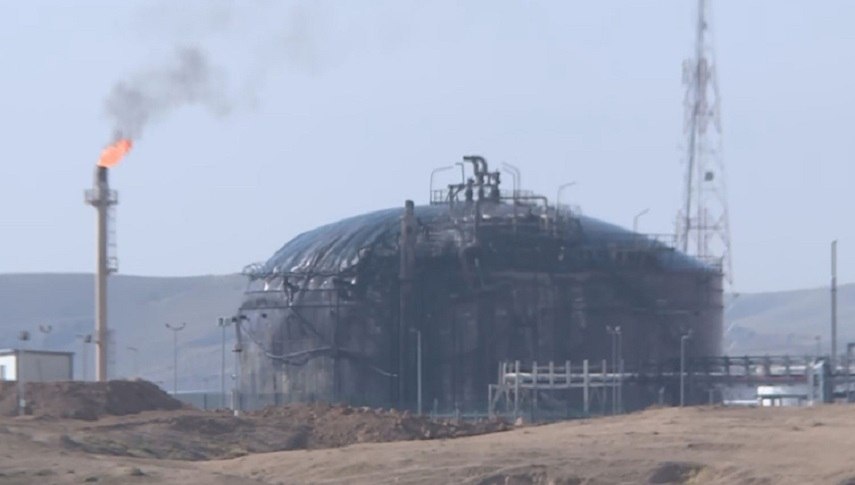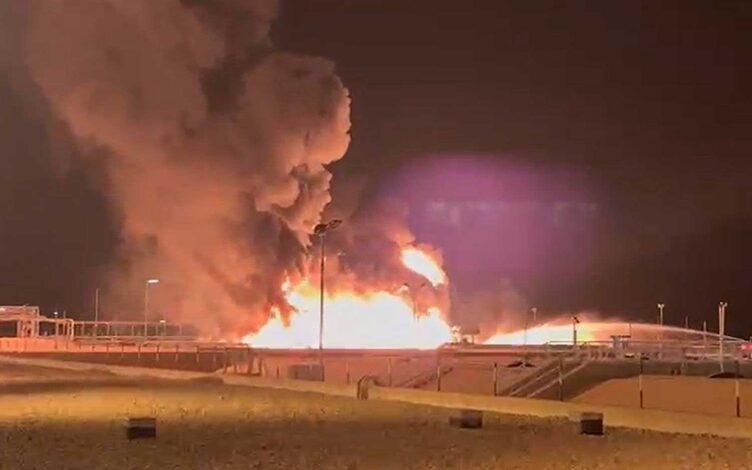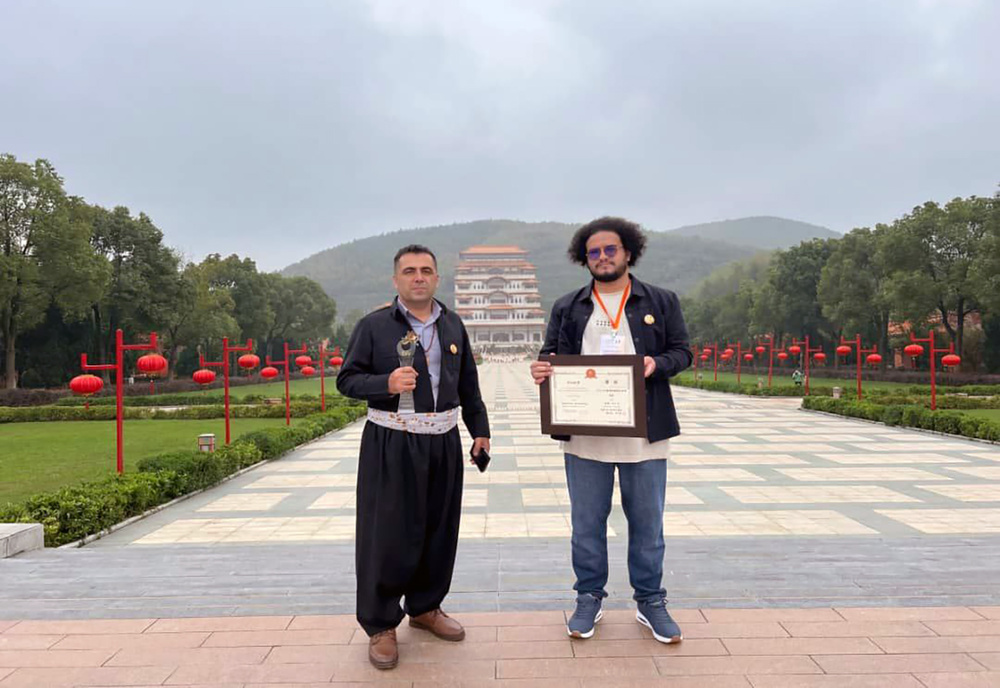Garbed in red tunics and white helmets, they gave a final salute with trumpets and clarinets before caskets covered in white flowers and draped with the flags of Iraq and Kurdistan were taken away in hearses.
First lady Shanaz Ibrahim Ahmed, a slight figure in a simple black suit, approached the caskets and broke down in tears.
They carried the remains of 172 people, mostly women and children, found in mass graves in Samawah, southeast of Baghdad. They were rounded up in 1988, along with tens of thousands of others, from their town, Chamchamal, and taken by truck to a remote desert for extermination.
The systematic campaign of mass killings came to be known as the Anfal genocide — perpetrated by the regime of Saddam Hussein.
After four years of political wrangling and bureaucratic hurdles, the first lady had cut through the red tape in order to secure the remains. She planned to take them home to Kurdistan for a dignified burial in the presence of their families and community.
The issue of mass graves in Iraq came into the international spotlight after the 2003 Iraq war. Sites where bodies were dumped have been discovered throughout the country and contain mostly ethnic Kurds and Shiite Muslims, as well as foreign nationals, including Kuwaitis and Saudis. Some 273 mass graves have been excavated so far, and the remains of an estimated 300,000 people are thought to be in these mass graves.
The mass graves discovered across the country correspond to atrocities perpetrated by the regime at different points in time. These include the crackdowns on Shiite activists in 1979 and 1982, the attack against the Barzani tribe in 1983, and the Anfal campaign in 1988, which resulted in the deaths of 182,000 Iraqi Kurds. There were also chemical attacks on Kurdish villages from 1986 to 1988 and the 1991 massacre of Shiite Muslims after the Shiite uprising at the end of the Gulf War. In 1999, thousands of Shiite Muslims are believed to have been arrested, imprisoned and executed after a second uprising.
Hisham Al-Alawi, deputy foreign minister for political planning and member of the Panel of Experts at the International Commission on Missing Persons, says the file of missing persons and mass graves has been a priority for successive Iraqi governments since the 2003 war, although he concedes that more resources could have been allocated “had it not been for the economic crisis, the pandemic, and the attacks of terrorist organizations.”
“The program of the current government includes several provisions to support the file, and the operations of opening and excavating graves are ongoing, in addition to identifying the victims and returning them to their families,” he said.
Still, there have been obstacles.
“Most of the mass graves are located in remote desert and risky areas still witnessing security violations, especially the mass graves left by Daesh,” Mr. Al-Alawi said.
The presence of unexploded explosive devices and bombs further complicates conditions.
“There is also the risk of infection for many members of the work team who come into contact with diseases and epidemics as a result of working with cadavers,” he said.
Even when the graves are excavated, the cost of preserving the remains in morgues in Baghdad is substantial, as is the forensics testing required to identify the bodies of those who have no identification on them.
Yet according to Mr. Al-Alawi, it is necessary to deal with this file in order to “restore the social fabric that dictatorial and repressive policies and wars have damaged.”
“Achieving peaceful coexistence and reconciliation among the communities in Iraq requires addressing all [cases of missing persons] in order to bring justice to the victims and their families and determine the fate of the missing,” he said. “We must also provide reparations to the families and the communities for the damage caused by terrorists and sectarian fighting. It is crucial that we acknowledge these violations and ensure they are not repeated.”
Jawhar Muhammad’s older brother Kerim was among the victims found in the mass grave in Samawah. Kerim was 17 when officers forcibly took him from his home, and he was carted off with others for execution.
“When I learned Kerim was finally found among the other martyrs, I was relieved, because we had answers at last,” Jawhar said. “We never found out what had happened to him, although we feared the worst. But then, for four years, his remains were kept in a box in a laboratory in Baghdad, and I couldn’t get over that. The indignity of it haunted me.”
Jawhar says he was not home the day the officers took Kerim and two of his other brothers, a sister and a nephew. Two of his uncles and a cousin were also taken. There has been no word of what happened to any of them.
“I certainly would love for all of them to be buried in a proper cemetery and to be able to visit their graves, like all people who visit the dead dear to them at their own graves, and not in a mass grave in the middle of the desert,” he said.
For the first lady, the cause is deeply personal. Although an ethnic Kurd, she is working to ensure that all Iraqi victims of mass murder, regardless of religion or ethnicity, are given dignified burials and their loved ones permitted to have closure.
Retrieving the remains of 172 people was a significant achievement for her after years of setbacks, but the night before the handover ceremony, she said, she was unable to sleep.
“The Health Ministry had sent me the jewelry found on some of the bodies. I am planning to personally hand them over to the Amna Suraka (Red Security Museum) in Sulaymaniyah, where they will be displayed as part of a special exhibit on genocide,” she said. “But all night, I could think of nothing but the poor innocent people who had once worn these pieces of jewelry.”
In Iraq, cemeteries across the country honor those killed in war and instability. They expanded at an unusually high rate during the war against the Islamic State group by those battling the scourge and its victims.
For example, the Wadi Al-Salam cemetery in Najaf, the largest in the world and final resting place for 5 million Muslims, doubled its rate of burials in 2016 at the height of the ISIS occupation. The families of Iraqis, of all sects, whose loved ones were slaughtered and dumped in unmarked graves during Saddam’s 1988 Anfal campaign in the north of the country and his 1993 Faith campaign in the south, deserve the same honor.
“This must be more than a cause,” the first lady said. “Iraq has been through so much in the past 45 years. Repression, wars, massacres and terrorism. Healing and reconciliation are a necessary part of rebuilding Iraq. Without reconciliation, we cannot move forward as a nation.”
Coming to grips with the genocidal legacy of Saddam Hussein’s reign is one step in moving forward.
By Tanya Goudsouzian

On a quiet mid-January morning, Iraqi honor guards assembled in front of the Health Ministry.
News ID 159523






Your Comment